Australia Genealogy Records
| Tweet |
|
Below is a list and description of the most recent genealogy records for Australia (see list of most recent records for other countries). Many of these records can be searched using our free genealogy search engine, which is particularly powerful for Australian genealogy records.
2016 January to June
Tasmania – FamilySearch.org has indexed an additional 70,000 civil registration records from Tasmania. These records span the years from 1839 to 1938. They consist of both government records and church records. Please note these are records from registries, as shown below. Access is free. [Tasmania Birth Records]
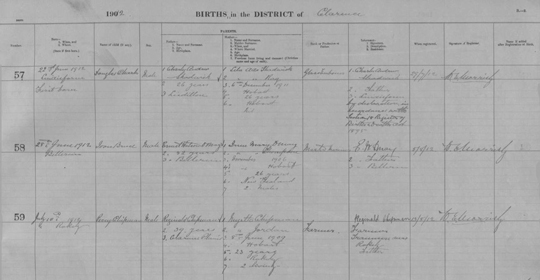
National – Just in time for ANZAC day on April 25th, Ancestry has released a new collection of Australian World War II military service records. These records cover army, navy and air force personnel. A typical record lists the following: full name, date of birth, place of birth, service number, marital status, religion, occupation (prior to enlistment), next of kin, any prior military service, details of any injuries and any transfers between units. These records can be searched by first name, last name, keyword and service number. Access is by subscription. [Australian WWII Military Service Records]
Please note that in order to access the full original service file, a request must be made to the National Archives of Australia. In fact, unless you are already an Ancestry subscriber, you are better off going directly to the National Archives website. They are the keeper of the original records. As well, you can search their website for free. [Australia Military Service Files]
Queensland – FindMyPast has put online Queensland birth and marriage records. There are some 930,000 birth records that span the years from 1829 to 1919 while the 700,000 marriage records are from 1829 to 1939. When looking at the birth records, it is important to realize that birth registrations in Queensland were not mandatory until March 1856. Therefore, it is perfectly possible to have someone born before March 1856 who does not have an official birth certificate. Also, be aware that Queensland was part of New South Wales until 1859. Finally, for a complete list of when different record sets first became available in various parts of Australia, please see this list.
As well, given how isolated some communities were in the 1800s, it is possible that a birth might be registered some time after the actual date. In particular, someone born in December might not be registered until January of the next year. Be aware of this when searching for the records and always use a wide date range in your search. The same logic applies when searching marriage records.
These records can be searched by first name, last name and registration year. Birth records can also be searched by father’s first name and mother’s first name. Please note that these are transcripts of the original records. A copy of the original record can be ordered from the Queensland government. Access is by subscription. [Historic Queensland Birth Records]
Western Australia – FindMyPast continues to increase their collection of Australian records. They have just put online Western Australian birth, marriage and death indexes. Note that these are indexes only. The birth index alone contains over 106,000 names. It lists the name of the individual, year of birth, place of birth and the registration number.
Once you have the registration number, you can apply to the government for the full birth record. Please note that Western Australia began keeping civil records of births, marriages and deaths starting 1 September 1841. To research ancestors prior to that date, it is necessary to consult church records. Access is by subscription. [Western Australia Birth Index]
National – The genealogy website Gould Genealogy has published a useful list of all the historic newspapers that are expected to be digitized and put into the Trove system over the next six months. A very useful list if you want to get a head start on your planning for 2016. [Gould Genealogy]
2015 July to December
New South Wales – FamilySearch.org has indexed an additional 326,000 records from the 1891 New South Wales census. This census lists the head of household, street address, and the number of male and female members of the household. There is also a separate column listing the “Number of Chinese and Aborigines” in the household. The collection can be searched by first name and last name. Access is free. [New South Wales 1891 Census]
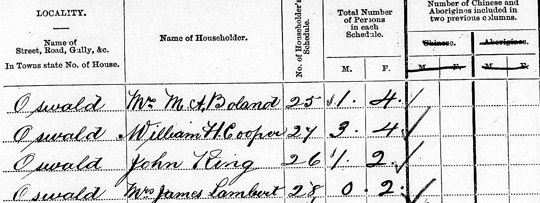
Western Australia – The State Library of Western Australia has just completed digitizing a series of local almanacs spanning the years from 1849 to 1889. These almanacs list local government officials and local businessmen (either through ads or directory listings). They also provide a wealth of local information. You can read more about this new collection in the official blog of the State Library of Western Australia. Access is free. [Historical Almanacs of Western Australia]
National – The UK website TheGenealogist has put online over 190,000 ship passenger records from England and Ireland to New South Wales. These passenger records span the years from 1828 to 1896. In addition to the usual information found in ship passenger records (name, port and date of departure, port and date of arrival, etc.), some of these new records also list additional information such as the passenger’s occupation, name of employer and salary.
TheGenealogist now maintains fairly extensive emigration databases from the UK to various colonies and they continue to expand their capabilities in this area. The records can be searched by first name, last name and year. Access is by subscription. [Australia Ship Passenger Records]
Victoria – FindMyPast.com has put online historic mental hospital records from the State of Victoria. The collection covers 11 institutions. Admission records span the years from 1811 to 1919 and discharge records span the years from 1838 to 1914. Although details vary by institution, a typical record lists name, date of admission, age, date of discharge, method of discharge and hospital. Some records are much more complete and include medical histories. These records can be searched by first name, last name, year and hospital name.
Mental health hospital records are an excellent source to search for genealogists looking for ancestors who appear to have dropped off the face of the earth. Sometimes, they ended up in mental hospitals. Access to the collection is by subscription. [Historic Victoria State Mental Health Records]
Queensland – FamilySearch has indexed some 335,000 cemetery records from Queensland. These records span the years from 1802 to 1990. The records are part of a 1.1 million image collection of indexes, cemetery transcripts and burial records. Cemetery records often provide more information than church death records, particularly on children that died young.
Australia cemetery records are also sometimes useful for finding the maiden name of women. The indexed records in this collection can be searched by first name and last name. The images can be searched by cemetery. Access is free. [Historic Queensland Burial Records]
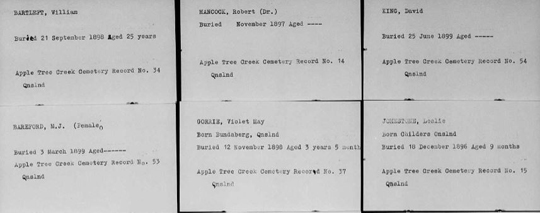
2015 January to June
National – The Ryerson Index has just reached the important milestone of 5 million names. For those who are not familiar with the Ryerson Index, it provides a free index to Australian obituary and probate notices found in historic newspapers. The notices go back as far as the Sydney Gazette of 1803 and as far forward as the present.
Although the Ryerson Index traditionally focussed on newspapers from New South Wales, it now covers much of Australia. A typical search will provide the last name, given name(s), type of notice (death notice, probate notice), date of death, age of person at death, newspaper, publication date and a reference to the town/city where the person last lived. Access is free. This is a great resource for anyone with Australian ancestors. [Ryerson Index]
New South Wales – FamilySearch.org has started a new browsable image collection of the 1828 census from New South Wales. So far, 2,500 images are in the collection. A sample image is shown below from Botany Bay. The 1828 census lists the name of the family member (including servants), age, class (free or bonded), ship name and year of arrival, sentence (if applicable), employment, residence and religion. If the resident was a farmer, additional information was also collected such as the number of acres and livestock totals.
Two copies of the 1828 New South Wales census were created. One copy was sent to the public records office in England. This is the basis for the copy Ancestry keeps in its collection. The other copy is now resident in the Mitchell Library in Sydney, which is the basis for the FamilySearch version. It is worth consulting both versions since there appears to be slight differences between the two sets (particularly in name spelling).
The images in the FamilySearch collection can be searched by place. Eventually, it will be indexed by name. Access is free. [New South Wales 1828 Census]

Tasmania – FamilySearch.org has created a new browsable image collection of Tasmanian civil registrations of births. The collection consists of some 12,700 images and spans the years from 1899 to 1912. A typical record (as shown below) gives the name of the child, date of birth and sex. For the father it lists the name, age and birthplace. For the mother it lists the name, maiden name, age, when/where married, place of birth and other children.
The images in this collection are organized by place and then by year. For this collection there is often a long lead time between when the child was born and when it was registered. It is possible that children who died soon after birth were not put in the register in Tasmania during this time period. Access is free. [Historic Tasmanian Birth Records]

Tasmania – FamilySearch.org has created a new browsable image collection of Tasmanian government gazettes from 1833 to 1925. Government gazettes are a great source of information for genealogists because of the wide breadth of records they contain, as shown in the image below. This particular gazette lists everything from convict lists, to ship arrivals to details on property sales. The collection can be searched by date. Access is free. [Historic Tasmanian Government Gazettes]
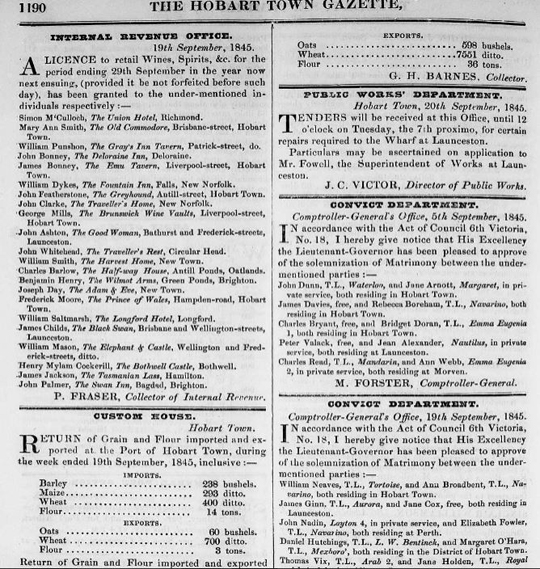
Queensland – FindMyPast has put online an index of Queensland wills. The index consists of some 514,000 records spanning the years from 1857 to 1940. The index was compiled from three former Queensland Supreme Court districts: the Northern District (based in Townsville); the Central District (based in Rockhampton) and the Southern District (based in Queensland). The index provides details of not only those who died in Queensland, but also those who registered their wills in Queensland and then lived elsewhere at the time of their death.
Each record includes a transcript of the original files. The index can be searched by first name, last name and district. Access is by subscription. [Queensland Will Index]
New South Wales – FindMyPast.com has put online early editions of the government gazette of New South Wales. The collection spans the years from 1832 (the start of the gazette) to 1863. This was the official newspaper of record for the state government. It was used as a means of communication between the government and the general public. It recorded a broad spectrum of community matters such as land sales, court notices, petitions, licenses, contracts, police activity, etc.
The gazette also contains a considerable amount of detailed information on convicts. For example, the 1833 gazette provides lists of all male convicts, when they arrived in the colony, ship name, occupation and convict number. Records on government employees are also prominent in the gazette. There are some 1.2 million original transcripts in the collection. The collection can be searched by first name, last name and year. Access is by subscription. [New South Wales Government Gazette]
Tasmania – FindMyPast has added a collection of Tasmanian birth, marriage and death records. The collection starts in 1803 and runs to 1899 for marriages and 1933 for births and deaths. There are some 211,000 birth records, 111,000 marriage records and 102,000 death records. The amount of information available varies depending on the type of record and when the record was registered.
In general, newer records contain more information. For example, on death records after 1908 the deceased person’s spouse was listed (or if single, the parents’ names). These records can be searched by first and last name, year and place. Access is by subscription. [Tasmania Birth Marriage Death Records]
2014 July to December
New South Wales – Ancestry has added a collection of court records from New South Wales. The some 200,000 records span the years from 1830 to 1945 and can be searched by name, location, year and keyword. This collection of court records are primarily criminal cases. Access is by subscription. [Historic New South Wales Criminal Court Records]
New South Wales – Ancestry.co.uk has put online some 273,000 records of seamen from New South Wales. These are registers and indexes of seamen from the State Records Authority of New South Wales. This collection spans the years from 1859 to 1936. The information in each record varies. Typical information includes such things as name, age, date of birth, place of birth, vessel, vessel owner, engagement and discharge date. The collection can be searched by name, year of birth, place of birth and keyword. Access is by subscription. [Historic New South Wales Seamen Records]
New South Wales – Ancestry.co.uk has put online a collection of land grants from New South Wales. The collection consists of some 190,000 records spanning the years from 1788 to 1963. The records come from various land record offices in the state. The format of each record varies by time and place but usually include the date, location of the grant, description of the land, name of the person the land was granted to, the amount paid for the grant and names of witnesses to the document. The granting of free land in New South Wales ceased in 1831. After that time, land grants were sold by public auction. This collection can be searched by name, location and keyword. Access is by subscription. [Historic New South Wales Land Grants]
Victoria – FindMyPast has added ship passenger lists for the State of Victoria, which includes Melbourne. The inbound passenger lists span the years from 1839 to 1923 (some 2.1 million records in total) and the outbound passenger lists cover the years from 1852 to 1915 (some 1.8 million records in total). These records come from the Public Record Office in Victoria and cover the gold rush period of the 1850s when thousands of English immigrants flocked to the area. A typical record lists the ship name, passenger name, estimated year of birth, nationality, original point of departure, departure port, destination port and month and year of arrival. Access is by subscription. [State of Victoria Historic Passenger Lists]
2014 January to June
Australia – The National Library of Australia has made another massive addition to their newspaper collection on Trove. This latest addition covers 35 historic newspapers from around the country. The greatest concentration of newspapers in this latest update is from New South Wales. Most of the new additions cover the date range from about 1875 to 1960, with many in the 1910 to 1945 era. Most of the additions appear to be from small towns. Access is free. [Trove Historic Newspapers] Trove can also be searched using the free Genealogy Search Engine.
National – The National Archives of Australia and the New Zealand Archives have joined forces to create a new website called Discovering Anzacs. The objective is to create a profile of every Anzac who enlisted in World War I complete with their service record. People can also contribute their own personal family stories and photographs as well as help transcribe war diaries and service records. The brief video below describes the process. Access is free. [Discovering Anzacs]
National – FindMyPast.com.au has added a collection of some 640,000 convict records. The collection consists of two parts: 515,000 New South Wales and Tasmania settler and convict records (1787 to 1859) and 125,000 convict transportation registers (1787 to 1870). The NSW record set consists of transcripts, indexes and original handwritten records relating to convicts, former convicts and settlers. A typical record lists a person’s year of birth, ship and year of arrival to the colony, occupation and place of residence. The convict transportation registers lists ship and year of arrival, details on sentencing and the term of the sentence (typically 7 years, 14 years or life). An estimated 20% of Australians are thought to have a convict ancestry, suggesting this record set will be of interest to many people. Access is by subscription. [Australian Convict Records]
Victoria – FamilySearch.org has indexed 1 million records from their State of Victoria probate register collection. The collection covers the years from 1841 to 1989 and generally involves wills. A typical record lists the name of person, date of death, address, occupation, date of testament and a declaration. Most wills list names of children, names of heirs, name of the spouse and name of the administrator of the will. Access is free. [State of Victoria Probate Records]
National – The website Claim a Convict is being relaunched on Australia Day. The new website is curated by Michelle Nichols and Jonathan Auld, who took over when Lesley Uebel fell ill. [Claim a Convict]
2013 July to December
National – A new website has launched in Australia devoted to creating a large biographical database of Australians. Known appropriately as the Biographical Database of Australia (BDA), it already contains some 500,000 records. According to the website, this first batch of records contain convict, muster, census, baptism, marriage and burial records from New South Wales (1788 to 1828) and for Norfolk Island & Tasmania (1802 to 1811). In the future, data will be added for all states and territories. BDA is a not-for-profit database that is the result of years of work by volunteer genealogists, historians and contractors. This website is well worth checking out if you have Australian ancestors. The indexes can be searched for free. There is a fee to see the underlying records. [Biographical Database of Australia]
New South Wales – Ancestry has published a small but important list of teacher’s rolls from New South Wales. The collection consists of about 16,000 names and spans the period from1869 to 1908. This collection can be searched by name, year and keyword. Details in the rolls include age at the time of hiring, training, promotions, teaching classification, employment history listing schools and dates, any awards or reprimands, salary and marital status. Access is by subscription. [New South Wales Teacher’s Rolls]
2013 January to June
National – The National Library of Australia has been busy adding digitized newspapers to Trove. Most of the latest additions are from New South Wales and South Australia from the following towns/cities: Sydney (1911 to 1914), Brisbane (1926 to 1954), Port Lincoln (1927 to 1954) and Port Elliot (1866 to 1954). Trove has over 8 million pages of digitized Australian newspapers. Access is free. [Trove Newspaper Collection]
The National Library of Australia also has a series of excellent videos describing the resources that are available for family history research, which you can view below. They are well worth watching (the videos will automatically run one after the other).
National – The National Archives of Australia is looking for volunteers to help transcribe records. They have created a special section on their website called arcHIVE for anyone interested in transcribing records. To make the process easier, every document awaiting transcription is identified as easy, medium or hard. You also have the option of choosing the type of record that you would like to transcribe. This allows transcribers to work at their own pace and comfort level from their own home. What could be easier? [Transcribing National Archive of Australia Records]
2012 July to December
National – Trove continues to add more newspapers to its impressive free collection. The latest additions are from South Australia and Victoria. Included are various newspapers from Adelaide that cover the period from 1858 to 1895 and various small-town newspapers from across the state of Victoria that primarily cover the World War I period. Access is free. [Trove Historic Newspapers]
Tasmania – FamilySearch.org has added a new collection of some 96,000 images of various Tasmania genealogy records. This collection spans the years 1829 to 1961and includes land records, school records, court records and occupation/guild records. Details on Australian convicts can be found buried in the court records. There are four types of convict records (tickets of leave, certificates of freedom, pardon and convict indents). The records are organized by location. Access to the collection is free. [Tasmania Genealogy Records]
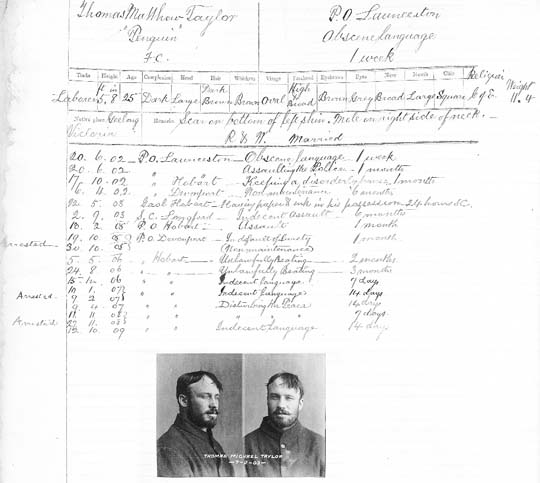
Western Australia – The State Library of Western Australia has digitized and put online the Police Gazette of Western Australia. This collection spans the years from 1876 onwards. This gazette basically lists all the police activity by year. Typical information would include a list of people arrested and their sentences, police appointments and promotions, conditional pardons issued to convicts, physical descriptions of convicts, etc. (see the example below). This gazette contains a wealth of information for anyone looking for criminal or police records in Western Australia. Access this collection is free. [Western Australia Police Gazette]
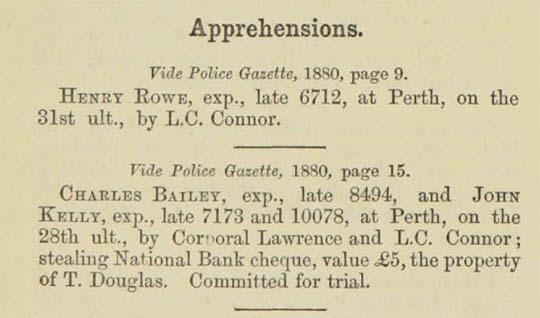
Australia – The Queensland State Archives has released a new index of original shipping registers for vessels that arrived in Queensland from 1848 to 1912. A typical record lists the name of the ship, European port of departure, date of departure, place and date of arrival in Queensland, list of passenger and type of passage (free, assisted, remittance, bounty, steerage, etc.).
This index is for ships from the United Kingdom and Europe. It does not include ships from New Zealand, the Americas, Asia, Africa or other Australian ports. As well, some of the records from the 1860s are missing due to damage incurred in the Queensland 1893 floods. These indexes can be searched alphabetically by last name. Access is free. [Historic Queensland Shipping Registers]
National– FindMyPast.com.au has just added another 56 million genealogical records covering Australia and New Zealand. This brings the total for the website to over 135 million records. The records consist primarily of census records, land records and survey records in addition to the usual birth, marriage and death records. Access is by subscription or pay-as-you-go. [Australian and New Zealand Genealogy Records] We feel compelled to mention that the Genealogy Search Engine also has just as many Australian and New Zealand genealogy records and it is free.
National – GenealogyInTime Magazine has added 400 million new records to their two free search engines. The Genealogy Search Engine (which covers ancestral records) now searches an additional 100 million more records, while the Family Tree Search Engine (which covers genealogy forums and online family trees) searches approximately 300 million more records.
In total, the two search engines now cover 5.7 billion records across more than 1,000 different websites (split between the Genealogy Search Engine covering 1.9 billion records and the Family Tree Search Engine covering 3.8 billion records – there is no overlap of records between the two search engines).
GenealogyInTime Magazine now gets over 40,000 queries per month for the two search engines. This makes them one of the most popular alternatives to the FamilySearch website for people wanting to look for free ancestral records. Significant holdings exist for the United States, Canada, England/Wales, Scotland, Ireland, Continental Europe, Australia and New Zealand with minor holdings for the Caribbean, South America and South Africa.
Some of the highlights of the latest addition to the Genealogy Search Engine include:
• 55 million new records for the United States and 6 million new records for Canada. These are primarily ancestral records held in digital archives of public libraries and universities across North America. Many of these new records are historic photographs.
•23 million new records for England, Ireland and Scotland. These are primarily twentieth century obituaries.
• 14 million new records for Europe. These are primarily birth/marriage/death records from Central and Eastern Europe.
• 2 million more ship passenger records.
In this latest release, the search routines for both search engines have also been strengthened to provide better results. In addition, the number of returned records for a search query has been increased from 8 pages to 10 pages. Finally, results are delivered even faster than before.
Access to both search engines is free and the underlying records are also free. [Genealogy Search Engine] [Family Tree Search Engine] GenealogyInTime Magazine also has a number of genealogy articles to help you become better at online genealogy searches.
GenealogyInTime Magazine is the world’s most popular online genealogy magazine. It is also now the fifth largest free genealogy website in the world (according to Alexa, the internet traffic people, the largest free genealogy websites in order are FamilySearch, Find A Grave, Geni, GeneaNet and GenealogyInTime Magazine).
2012 January to June
Queensland – Ancestry has created a new collection called Far North Queensland: Pioneers and Settler Registers (1825 to 1940). As the name implies, this database contains registers of pioneers and settlers from the far northern part of Queensland. The collection comes from data collected by the Cairns and District Family History Society. The type of information contained in the database include names, place and date of birth, parent’s names, spouse’s name, children’s names and birth dates as well as residence. For some pioneers, other information is also available, such as place and date of marriage, occupation, religion, date of death and date and place of arrival in Australia. The database can be searched by name, event (birth, death, marriage) and keyword. Access is by subscription. [Queensland Pioneer Records]
New South Wales – Ancestry.com.au has added two new convict collections. The first called NSW Convict Indents (1788 to 1842) lists all convicts transported to New South Wales. A typical record gives the name, date and location of trial and the sentence. Later records in the collection also list occupation, physical description and to whom the convict was assigned. The second collection is called NSW Colonial Secretary’s Papers (1788 to 1856). It provides government records of day-to-day life in early Australia. This collection includes letters and complaints received by the government, marriage permission requests, character references for potential settlers, pardons, applications for sentence mitigation, grant applications, office appointments, etc. Access is by subscription. [Historic Australian Convict Records]
Queensland – FamilySearch.org has added a new collection of some 1.1 million images of Queensland cemetery records. The images date from 1802 to 1990 and are organized by the name of the cemetery. A typical cemetery record lists the name of the individual, date of death and age. Access is free. [Queensland Cemetery Records]
2011 October to December
National – The digitized newspaper collection of Trove has added more newspaper titles. Highlights from the latest additions are the Geraldton Guardian (1906 to 1950), the Perth Inquirer (1840 to 1901), the Traralgon (Victoria) Record (1886 to 1932) and the Central Queensland Herald (1930 to 1939). Access is free. [Historic Australian Newspapers]
National – Trove has continued to expand its digital newspaper collection. A total of 13 new newspaper titles have been added for Victoria. Most of the newspapers are from the 1880 to 1900 era. Trove is a definite go-to site for anyone researching their Australian ancestors. Access is free. [Historic Victoria Newspapers] Trove is also one of the many sites that can be searched as part of the free genealogy search engine.
Commonwealth - Ancestry.co.uk has published details on the 880,000 soldiers who received Silver War Badges (SWB) in World War I. These were small, circular badges made of silver, with the king’s initials, a crown and the inscription ‘For King and Empire’ and ‘Services Rendered’ (see image below). They were granted to soldiers who had been honourably discharged from the war due to wounds or illness.
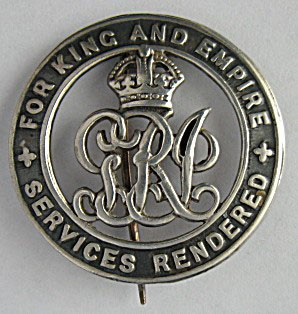
The SWB was intended to be worn with civilian cloths (it was forbidden to be worn on a military uniform). The SWB was given to discharged soldiers to prevent them being accosted by women with white feathers (a symbol of cowardice), which were presented to able-bodied men on the home front who were not wearing a uniform. This collection includes SWBs given to soldiers across the Commonwealth. A typical record lists name, rank, regiment number, unit, date of enlistment, date of discharge and reason for discharge. Many service records from World War I were lost. If you suspect this may have happened with your ancestor, then you should check this collection. Sometimes, the SWB record is the only record of military service that survived the Great War. Access is by subscription. [Silver War Badge Service Records]
Ireland – FindMyPast.ie has put online an interesting collection of Irish prison records. Specifically, these are the Irish Prison Registers covering the period 1790 to 1924. The collection spans some 2.7 million records on 3.5 million people. This is the first time this record set has gone online and it should be particularly valuable for anyone tracing their Irish ancestors. The population of Ireland was about 4 million during this time period. Thus, you have a pretty good chance of finding at least one ancestor in this collection.
The odds are further increased by the fact that in Ireland, the number one cause for incarceration was drunkenness, which tends to bridge across families and different socio-economic groups. According to FindMyPast, drunkeness and tax avoidance occurred at three times the rate in Ireland than in Britain and Scotland at that time. As well, some records list the victim as well as the perpetrator, making the record set even more valuable. The breakdown by offense was drunkenness 25%, theft 16%, assault 12%, vagrancy 8% and rioting 4%. Other common offenses were prostitution, obscene language, begging, trespass and workhouse offenses.
Prison record sets generally provide much more detail than most other sources of genealogical information and this record set is no different. A typical record in this collection lists name, address, place of birth, occupation, religion, education, age, physical description and name and address of next of kin as well as details on the crime committed, sentence, date of committal and date of release. This is also a good record source to search if you are in Australia as many Irish convicted of petty crimes were transported from private prisons in Ireland directly to Australia in the 1800s. Access is by subscription. [Historic Irish Prison Registers]
2011 July to September
Tasmania – The Tasmanian government has created Tasmania Archives Online, a website that contains descriptive and contextual information on Tasmanian state and local government records. The website also lists private records of individuals that are in the possession of the government. Although you cannot view the content of most of the records online, this website can identify for you whether certain records do exist. For example, the website lists the various series of records for convicts arriving on certain ships. The website also contains a broad list of many other things, such as census records, various historic reference books, various historic maps etc. This is a good place to start a search for your Tasmanian ancestors. Access is free. [Historic Tasmanian Genealogy Records]
Commonwealth – GenesReunited.co.uk has added about 1.3 million military records from various Commonwealth countries. The records date from the Second Anglo-Boer War (1899 to 1902) and World War I (1914 to 1918). Include are the following collections: lists of the men and women who fought during the Second Anglo-Boer war; Commonwealth soldiers who died in WWI; Royal Navy officer’s medal role (1914 to 1920) and New Zealand World War I male and female service personnel. Access is by subscription [Commonwealth World War I Military Records]
National – TheGenealogist.co.uk has added a major new collection of Australian convict records. Included are both male and female convicts, with details of their sentences and pardons (if any). The records primarily cover New South Wales (1788-1834) and Tasmania (1808-1849). Also included in this collection are general muster lists, the New South Wales 1828 census, and ledger returns for Tasmania (1846 and 1849). Access is by subscription. [Historic Australian Convict Records]
National – Ancestry.com.au has amalgamated their various Australian immigration databases into one search function. Basically, the new search function makes it easier to search across all the databases from one web page. The entire Australian immigration collection totals some 14.5 million records and covers the period 1788 to 1923. Access is by subscription. [Historic Australian Immigration Records]
2011 April to June
New South Wales – Ancestry.com.au has added two more collections. The first is some 6,000 admission/departure records for the Randwick Asylum for Destitute Children (1852-1915), which was based in Sydney. The second collection is New South Wales publican’s licences covering the periods 1830-1849 and 1853-1860. These are licences that gave various establishments the legal right to sell alcohol. This would be a good collection to check if your ancestors owned a pub in New South Wales. Access is by subscription. [Historic Australian Pub Licenses]
National – GenesReUnited has revamped their passenger list collection. This will be of interest to anyone with ancestors who emigrated from a British port between 1890 and 1960. The records list the passenger’s name, age, date of departure, departure port, destination port and the name of the ship. Some records list additional information, such as UK address, year of birth, marital status, occupation and nationality. In total, this collection lists some 24 million passengers. GenesReUnited states that it’s collection is particularly strong for passenger lists for ships sailing to Australia. Access is by subscription. [Ancestors on Board]
National – The National Centre of Biography at the Australian National University has created a new website called Obituaries Australia. It is meant to complement their existing Australian Dictionary of Biography, which lists notable Australians. Unlike most obituary websites, which focus on current obituaries, Obituaries Australia contains the life stories of Australians from its earliest days to the present. Basically, the website serves as a digital repository of obituaries that were previously published in newspapers, journals, magazines and bulletins. Anyone can submit an obituary from a published source. It is also a good website to search for your ancestors. Access is free. [Obituaries Australia]
National – The Australian government has put online a new database that lists patent applications going back as far as 1904. The database contains over 1.6 million patent applications covering all of Australia and can be searched by inventor’s name (including spelling variations) as well as type of invention. This is not the normal type of website that a genealogist would think to look at but it might be a great website to search if you think one of your ancestors may have been an inventor, scientist, engineer or tinkerer. Certainly, it doesn’t hurt to take a look. Access is free. [Historic Australia Patent Applications]
National – The National Archives of Australia has created a valuable new resource for Australian genealogists called Mapping Our Anzacs. It is a web map that serves as a type of online scrapbook of World War I ‘diggers’. This interactive map allows you to view individual military service records, build tributes and attach memories. One interesting thing about this map is that it allows you to search for ancestors by place instead of just name. This is an excellent resource for anyone with ancestors from Australia who fought in World War I. Access is free. [Mapping Our Anzacs]
2011 January to March
National - Ancestry has expanded its Australian convict collection with 42,000 new records that focus on convicts who were given parole for good behaviour. Access is by subscription. [Historic Australian Convict Records]
Queensland – The State Library of Queensland has generously donated 50,000 archived photos to be used free of charge on Wikimedia Commons (i.e. copyright free). As far as we know, this is the largest single donation of historic genealogical photographs put into the public domain. This collection is a great source for anyone with Queensland ancestors or for anyone who is looking for historic photos for their blog or website (in addition to the 500+ genealogy photos from GenealogyInTime™ that you can use on your website).
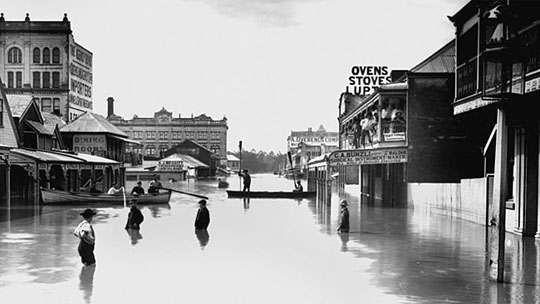
The images in this collection go back well over one hundred years and include many portraits and group photos. Access is free. Note that only a few thousand images have been added to the website. More will be added over the coming weeks. [Collection of Historic Queensland Photographs]
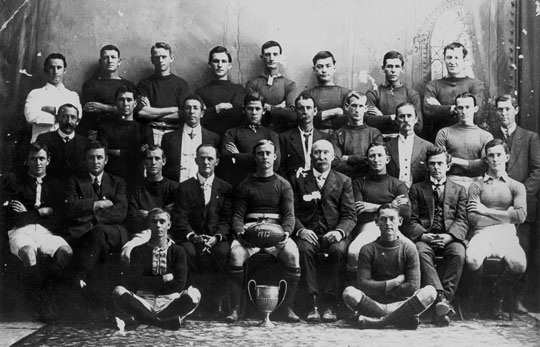
2010 October to December
National – The Australian government’s historic newspaper website Trove has reached the milestone of 32 million historic articles online. An additional 10 million articles are expected by June 2011. All of the articles are searchable by name and keyword. The latest batch to go online includes the complete Sydney Morning Herald from 1842 to 1954. The focus over the next nine months is to digitize historic newspapers from South Australia and Western Australia. Access is free. [Trove Historic Australian Newspapers]. As well, you can access Trove results for free through the free Genealogy Search Engine.
New South Wales – FindMyPast has added 233,000 burial records for Rookwood Cemetery in Sydney. The records cover the period from 1798 to 1999. Rookwood is the largest multicultural cemetery in the Southern Hemisphere containing Anglican, Catholic, Protestant, Jewish and Muslim graves. It is estimated that a total of 1 million people are buried in the cemetery. Each record on FindMyPast contains name, date of death, age at death, plot location and inscription on the gravestone. Access is by subscription. [Rookwood Cemetery Records]
2010 July to September
UK - Ancestry has made a new database available called the Prison Hulk Registers and Letter Books 1802-1849. This is a database of almost 200,000 convicts held on prison ships. Each record lists the inmate's name, year of birth, age, year and place of conviction, offense committed, name of the prison ship (which are called hulks) and character reports on the prisoner written by the jailer. Many of the convicts were awaiting transport to Australia, making this record set of particular interest to anyone wanting to trace Australian ancestors. In the genealogy world, prison record sets are rare. Access is by subscription. [UK Prison Hulk Registers 1802-1849]
National – Ancestry has created a master index of Australian birth, marriage and death records spanning the years 1788 to 1985. This is big news for Australian genealogists. The project took four years to complete and covers nearly 15 million records. The index was built from a variety of sources, including state record offices and archives. One caveat is that the current population of Australia is some 22 million people. Doing a back-of-the-envelope calculation that assumes the number of death records should be about half of the number of birth records and the number of marriage records should be roughly one quarter of birth records. Comparing this to the current population of Australia and this suggests that there should be more than 15 million records available, even given Australia’s large immigration component.
The actual database at the moment has 4.5 million births, 5.6 million deaths and 4.9 million marriages. The birth records run to 1922, the marriage records to 1949 and the death records to 1985. Still, this is excellent news. Ancestry has already committed to adding more records. Furthermore, Ancestry has made it very easy to search the new index by various means: name, father’s name, mother’s name, year, birth place, death place, spouse’s name, etc. Access is by subscription. [Historic Australian Birth, Marriage, Death Records 1788-1985]
2010 April to June
National – The Australian National Library has launched a wonderful new site for genealogists wanting to trace their Australian ancestry. Called Trove, it searches multiple online sources (not just the National Library resources) for Australian content and genealogy collections. Included in the searches are Australian newspapers (1803 to 1954), maps, diaries, letters, photos, books, journals, articles, music, sound, videos and archived Australian websites (1996 to present). You can search the website by a variety of means, including by name. We predict this will become the go-to website for Australian genealogy. Access is free. [Historic Australian Newspapers 1803-1954]
National – The National Library of Australia has made several improvements and upgrades to their online newspaper collection. The Sydney Morning Herald has been digitized from 1831 to 1954 and is now online. There are still some missing issues (about 3,500 in total), which will be online by July 2010. Two other newspapers added this week are the Queenslander (1866 to 1939) and the Camperdown Chronicle (1877 to 1954). The National Library of Australia has also launched this week and new and vastly improved online newspaper website. Just follow the link. Access is free. [Historic Australian Newspaper Collection]
2010 January to March
National – The National Library of Australia’s Australian Newspaper website has now indexed almost 14 million newspaper articles. The website has newspapers from all across Australia covering the time period from 1803 (for Sydney) to 1954. The site is still technically in beta and has a couple of quirky bugs (for example, highlights sometimes run through the middle of newspaper articles), but in general the site is well laid out with excellent navigation. Australian Newspapers expects to have 40 million articles indexed by the end of 2011. Access is free. [free Historic Australian Newspapers 1803-1954]
2009
National: The Ryerson Index, an index of death notices and obituaries from various Australian newspapers, has just completed indexing 2 million records. Access is free to the index. The detailed records are generally not available online. [Ryerson Index of Australian Obituaries]

